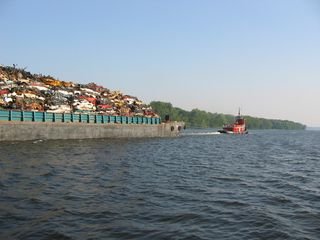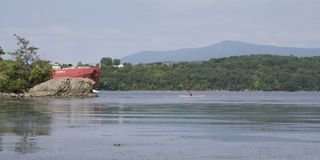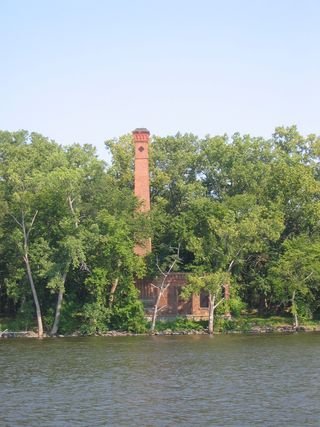One spring, I loaded up my kayak with sleeping bag and food and pointed south on the Hudson River. I was traveling with a former student, Emmet, and we intended to take a few days, camping on islands and on the banks of the river, to make our way from my village of Tivoli to Manhattan (I write about this adventure in my upcoming book, MY REACH). This is the freedom of a river, to head out and see what you can see. And I did see many marvelous things on my journey, and lots that I wish I had not seen. Day four I passed the Indian Point nuclear power plant. Instinctively, we scooted to the western shore, giving the plant a wide berth.
From water level, the towers loomed above me and the entire structure felt imposing. There are layers of red brick buildings smack against the river. Not a window in sight, as if whatever was contained inside shouldn’t be seen, and should not see out. I’d passed some large industry on the river—Trapp Rock up by Poughkeepsie, for instance, but nothing that felt ominous like the Indian Point plant. There are many reasons to protest nuclear power. In my life, the stories of Three Mile Island, Chernobyl and Fukushima are enough to convince anyone this is a risky source of energy. There are many reasons not to want a nuclear power plant so close to a major metropolitan area—9/11 is enough to show how vulnerable we can be. And there are many reasons not to want a nuclear power plant on the Hudson River. The plant rests on a small earthquake fault. And, the plant uses billions of gallons of water t o cool its towers and then spits this warmed water back into the river, altering the ecosystem. In the process, millions of fish are sucked into the plant and killed. But I had not thought about any of this with much care until I stroked past the plant low in my boat.
Floating in a kayak on a big river I often feel tiny, especially next to tankers or the barges that shove north and south at all times of day and night (in this photo, a tanker is emerging around Magdalen Island--that little dot is me). But my river view is an important perspective, it’s the same view a beaver might have, or a great blue heron wading by the shoreline. In a kayak, there is an intimacy with the water, whether that water is clean or not, the sights beautiful or not. And I did not like being intimate with a nuclear power plant. It took experiencing the chill of Indian Point on a cool rainy spring day to make me care about shutting down the plant.
And so it comes as good news that Governor Cuomo wants to shut down Indian Point and that new legislation will make this possible. This long battle may finally come to an end. According to Times reporters, Entergy, the company that runs the plant, came away from the meetings “alarmed” with the governor’s direct and strong intentions.
Even though I am skeptical that Indian Point will be shut down, I’m going to be naïve and pretend this is true. I have decided to begin my celebration by wondering what happens to a closed nuclear power plant. Will it join the history of closed industry along the river? When I paddle the length of the estuary, I have passed brick towers that are the remains of the icehouses (photo at left) that stored and brought ice to keep Manhattan cool. There are the sheds that were used in brick making just north of Kingston where teenagers now come to skateboard, the clatter of their leaps and landings echoing through the tall, metal-roofed buildings. There are the remains of the cement industry, and an enormous brick building near the water in Germantown that says “Cold Storage.” These ghosts of industry past I find intriguing, often beautiful. I slip onto shore and out of my boat and poke around these structures, wary of broken glass and often taking a brick as a souvenir. Manhattan is built from Hudson Valley cement and brick. In an odd nostalgia, I wish that this industry were still alive, but cement is reduced to three plants near Smith’s Landing, and the brick industry closed for good in 2001. Yet the end of these industries means a cleaner river, a quieter, calmer river for me to paddle on. One hundred years ago, would I have wanted to see the brick industry close?
So in a hundred years will someone paddle past the crumbling towers of Indian Point and wonder about nuclear power? Perhaps there will be a certain nostalgia as she wishes that we still had that plant generating electricity for New York City. Or will she wonder what we ever imagined was good or sane about nuclear energy?


